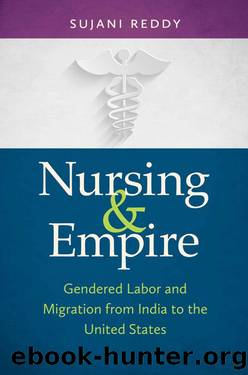Nursing and Empire by Sujani K. Reddy

Author:Sujani K. Reddy [Reddy, Sujani K.]
Language: eng
Format: epub
Publisher: The University of North Carolina Press
Published: 2015-09-10T04:00:00+00:00
âA typical village girl.â As a rural, marginally educated (âshe could not speak a word of Englishâ) Dalit girl, Jamesâs former student was truly among the most multiply oppressed Indian subjects. What was more, her caste, class, and gender positions combined to embody the historical stigmatization of nurses and nursing in India. And yet, in the United States, she appeared so utterly altered as to be unrecognizable. The stain of her stigmatization no longer read as a catalog of her condemnation so much as a mark for the extent of her transformation. She now served as a lesson in what hard work, individual determination, and attention to opportunity could achieveâfor anyone. The fact that in this case, the âanyoneâ was a rural Dalit woman summarizes the historic opportunity that immigration to the United States presented for Indian nurses, in particular. No longer were these workers left to toil under the leadership of colonial nursing leaders who had themselves migrated to the subcontinent in order to circumvent their own share of stigmatization. No longer was international migration an option open to a mere handful of selected Indian nurses who were meant to inherit leadership of the field from their colonial predecessors. After 1965, international migration, upward mobility, and the âgood life,â American style, were available even to one who could have otherwise been deemed a successor of Salome.
And yet, it would be untrue to the meaning of the message that I received from James, Eapen, or many other of my interviewees if we left it at that. They offer us a critical edgeâboth implicitly and explicitly. This story is not a simple or straightforward affirmation of the âAmerican Dreamâ at precisely a moment when that dream was taking on renewed global dimensions under the aegis of American ascendancy. Jamesâs studentâs story of transformation began not in the United States but in India and, more specifically, at the CON-D. While the CON-D was, on one hand, an open door outpost for professional nursing connecting the Indian workforce to the global market, the political terrain in postcolonial India was not as simple as that. As a central government institution, the CON-D was required to admit students from every state in India, as well as to allot reservations for students from the Scheduled Castes (SC) and Scheduled Tribes (ST). (SC/ST is government of India parlance for Dalits [ex-untouchables] and Adivasis [indigenous] peoples.) These reservations are one legacy of Dr. Bhimrao Ramji Ambedkarâs historic fight for justice as it linked up with his study of U.S. constitutional law at Columbia University and his role as the primary architect of the Indian constitution.57 In many ways, they parallel the postâcivil rights affirmative action programs in the United States and make a double claimâon India and the United Statesâto follow through on the promises of decolonization and desegregation.
There are several dimensions to this convergence. One is the overlap between model minority discourse and the discourse of Dalit advancement voiced so often by Indiaâs postcolonial elite and middle classes.
Download
This site does not store any files on its server. We only index and link to content provided by other sites. Please contact the content providers to delete copyright contents if any and email us, we'll remove relevant links or contents immediately.
| Administration & Medicine Economics | Allied Health Professions |
| Basic Sciences | Dentistry |
| History | Medical Informatics |
| Medicine | Nursing |
| Pharmacology | Psychology |
| Research | Veterinary Medicine |
1610396766 (N) by Jo Ann Jenkins(1297)
Elizabeth Is Missing by Emma Healey(1231)
McGraw-Hill Nurses Drug Handbook by Patricia Schull(1185)
Cherry Ames Boxed Set, Books 1 - 4 by Helen Wells(1154)
Economics and Financial Management for Nurses and Nurse Leaders, Third Edition by Susan J. Penner RN MN MPA DrPH CNL(1147)
The Language of Kindness by Christie Watson(1118)
Cherry Ames, Student Nurse by Helen Wells(1100)
NCLEX-RN Prep Plus 2019 by Kaplan Nursing(1096)
Spiritual Midwifery by Ina May Gaskin(1080)
Whoever Tells the Best Story Wins: How to Use Your Own Stories to Communicate with Power and Impact by Annette Simmons(1057)
Cherry Ames Boxed Set, Books 5 - 8 by Helen Wells(1051)
Home. by Sarah Graham(1049)
Cracking the Nursing Interview by Jim Keogh(1024)
1476763445 by Liz Fenton(1005)
Dementia by June Andrews(928)
Getting Started with Arduino by Massimo Banzi(922)
Cherry Ames, Army Nurse by Helen Wells(899)
Shadows of the Workhouse: The Drama of Life in Postwar London by Jennifer Worth(889)
Children's Medicines by Edward A. Bell(883)
